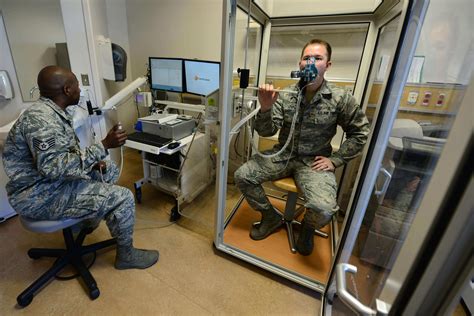Inside Air Force Cardiopulmonary Laboratory Testing

Understanding the Importance of Cardiopulmonary Laboratory Testing in the Air Force

Cardiopulmonary laboratory testing is a crucial aspect of maintaining the health and readiness of Air Force personnel. The Air Force Cardiopulmonary Laboratory plays a vital role in evaluating and diagnosing cardiovascular and pulmonary conditions, which can significantly impact an individual’s ability to perform their duties safely and effectively.
The Role of the Air Force Cardiopulmonary Laboratory

The Air Force Cardiopulmonary Laboratory is a specialized facility that provides comprehensive testing and evaluation services for cardiovascular and pulmonary conditions. The laboratory is equipped with state-of-the-art equipment and staffed by highly trained and experienced healthcare professionals. The primary goal of the laboratory is to provide accurate and timely diagnoses, which enable healthcare providers to develop effective treatment plans and ensure the optimal health and readiness of Air Force personnel.
Types of Cardiopulmonary Laboratory Tests

The Air Force Cardiopulmonary Laboratory offers a range of tests and procedures to evaluate cardiovascular and pulmonary function. Some of the most common tests include:
- Electrocardiogram (ECG): An ECG is a non-invasive test that measures the electrical activity of the heart. It is used to diagnose and monitor various heart conditions, such as arrhythmias and coronary artery disease.
- Stress Test: A stress test, also known as a treadmill test or exercise test, is used to evaluate the heart’s ability to function under physical stress. It is commonly used to diagnose coronary artery disease and assess cardiac function.
- Echocardiogram: An echocardiogram is a non-invasive test that uses sound waves to produce images of the heart. It is used to evaluate the heart’s structure and function, diagnose conditions such as heart valve problems, and monitor the effectiveness of treatment.
- Pulmonary Function Tests (PFTs): PFTs are a group of tests that measure lung function, including spirometry, plethysmography, and diffusion capacity. They are used to diagnose and monitor respiratory conditions such as asthma, chronic obstructive pulmonary disease (COPD), and pulmonary fibrosis.
- Cardiopulmonary Exercise Testing (CPET): CPET is a comprehensive test that evaluates the body’s ability to transport oxygen and carbon dioxide during exercise. It is used to assess cardiovascular and pulmonary function, diagnose conditions such as heart failure and pulmonary hypertension, and monitor the effectiveness of treatment.
The Process of Cardiopulmonary Laboratory Testing

The process of cardiopulmonary laboratory testing typically involves the following steps:
- Pre-Test Preparation: Patients are required to prepare for testing by avoiding heavy meals, caffeine, and strenuous exercise for several hours before the test.
- Test Administration: A trained healthcare professional administers the test, which may involve the use of specialized equipment such as electrocardiogram machines, echocardiogram machines, or pulmonary function testing equipment.
- Data Analysis: The test data is analyzed by a healthcare professional, who interprets the results and makes recommendations for further testing or treatment.
- Test Results: The test results are communicated to the patient’s healthcare provider, who uses the information to develop a treatment plan.
💡 Note: Patients should always follow the instructions provided by the healthcare professional administering the test to ensure accurate and reliable results.
Benefits of Cardiopulmonary Laboratory Testing

Cardiopulmonary laboratory testing offers numerous benefits, including:
- Early Detection and Diagnosis: Cardiopulmonary laboratory testing can detect cardiovascular and pulmonary conditions at an early stage, enabling prompt treatment and improving outcomes.
- Improved Treatment Outcomes: Accurate diagnoses and monitoring enable healthcare providers to develop effective treatment plans, which can improve treatment outcomes and reduce the risk of complications.
- Enhanced Safety: Cardiopulmonary laboratory testing can identify individuals who are at risk of cardiovascular or pulmonary complications, enabling healthcare providers to take proactive measures to prevent accidents and injuries.
- Increased Readiness: By ensuring the optimal health and readiness of Air Force personnel, cardiopulmonary laboratory testing contributes to the overall effectiveness of the Air Force.
Challenges and Limitations of Cardiopulmonary Laboratory Testing

While cardiopulmonary laboratory testing offers numerous benefits, there are also challenges and limitations to consider:
- Access to Testing: Cardiopulmonary laboratory testing may not be readily available at all Air Force bases or medical facilities, which can limit access to testing and create delays in diagnosis and treatment.
- Test Accuracy: The accuracy of cardiopulmonary laboratory tests can be influenced by various factors, including the quality of the equipment, the expertise of the healthcare professional administering the test, and the patient’s cooperation and preparation.
- Interpretation of Results: The interpretation of cardiopulmonary laboratory test results requires specialized expertise, which can create challenges in ensuring accurate and reliable diagnoses.
📝 Note: Healthcare providers should carefully evaluate the results of cardiopulmonary laboratory tests and consider the patient's medical history, symptoms, and physical examination findings when making diagnoses and developing treatment plans.
As we conclude our discussion on inside Air Force cardiopulmonary laboratory testing, it is clear that this specialized testing plays a critical role in maintaining the health and readiness of Air Force personnel. By understanding the types of tests available, the process of testing, and the benefits and limitations of cardiopulmonary laboratory testing, healthcare providers can ensure that patients receive accurate and timely diagnoses, which enable effective treatment and optimal health outcomes.
What is the purpose of cardiopulmonary laboratory testing in the Air Force?

+
The purpose of cardiopulmonary laboratory testing in the Air Force is to evaluate and diagnose cardiovascular and pulmonary conditions, which can significantly impact an individual’s ability to perform their duties safely and effectively.
What types of tests are available in the Air Force Cardiopulmonary Laboratory?

+
The Air Force Cardiopulmonary Laboratory offers a range of tests, including electrocardiogram (ECG), stress test, echocardiogram, pulmonary function tests (PFTs), and cardiopulmonary exercise testing (CPET).
How do I prepare for cardiopulmonary laboratory testing?

+
Patients should follow the instructions provided by the healthcare professional administering the test, which may include avoiding heavy meals, caffeine, and strenuous exercise for several hours before the test.